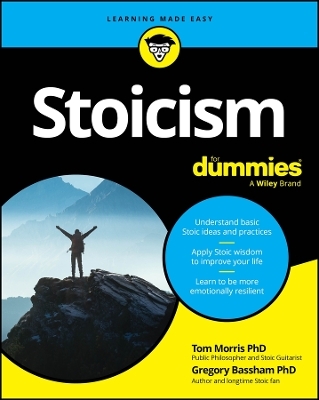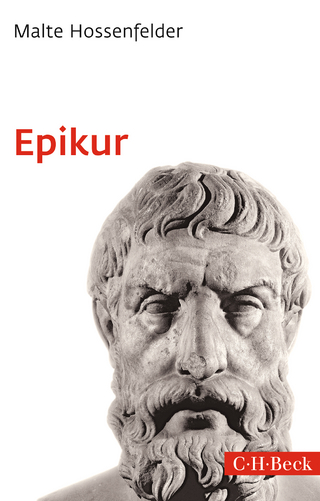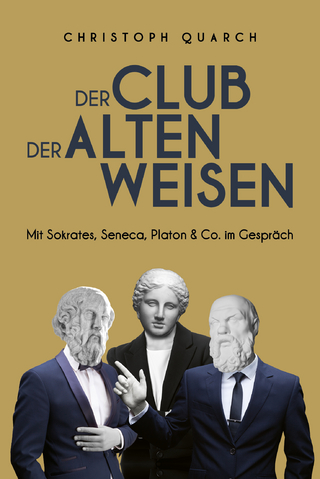
Stoicism For Dummies
For Dummies (Verlag)
978-1-394-20627-8 (ISBN)
Stoicism For Dummies will teach you the basic principles of stoic philosophy and show you how it can help you navigate the ups and downs of life. We all face challenges and setbacks, and, if we have the right mindset, we can sail through them with ease. This book offers a comprehensive look at Stoic philosophy, uncovering its strengths and attractions and shedding light on its limitations, both in the ancient world where it was developed, and in our world today. Learn how you can apply stoic principles for personal growth and better living, and how you can adapt this philosophical outlook to your unique circumstances. Written in terms anyone can understand, this friendly Dummies guide helps you understand stoicism, and also apply it in your life.
Understand the basics of stoic philosophy, including virtues and practices
Learn how to keep calm and carry on when life throws you curveballs
Apply stoic principles to improve your relationships and quality of life
Discover the history of stoicism and how its principles can apply to today’s world
This book is great for anyone who wants to learn more about stoicism and its benefits.
Tom Morris is author of Philosophy For Dummies and 30 other books. He was a philosophy professor at The University of Notre Dame and now heads The Morris Institute for Human Values. Gregory Bassham is author of The Philosophy Book, an illustrated history of philosophy, and 10 other books. Gregory was a professor of philosophy at King’s College.
Introduction 1
About This Book 1
Foolish Assumptions 2
Icons Used in This Book 3
Beyond the Book 3
Where to Go from Here 4
Part 1: Ancient Stoicism 5
Chapter 1: Stoicism: A Philosophy for Our Time 7
A Way of Thought for Our Time 8
Hot philosophy in America 9
The Stoic formula 9
What Does “Philosophy” Even Mean? 10
What Wisdom Is and Is Not 11
Two sides of philosophy 12
Philosophy and life 14
Using Wisdom with the Stoics 17
Happiness and freedom 18
When to go to philosophy 20
Chapter 2: Socrates and the Beginnings of Western Philosophy 21
Heraclitus the (Cranky and) Obscure 22
Socrates: The Barefoot Gadfly and General Pain-in-the-Patootie of Ancient Athens 24
Care for the soul 25
Virtue is sufficient for happiness 26
No harm can come to a good person 26
Virtue is knowledge 27
No one does wrong willingly 27
Diogenes of Sinope: Socrates on Steroids 27
Virtue is the only true good 28
Virtue is sufficient for happiness 28
“Follow nature” 29
Be a citizen of the world 29
Chapter 3: The First Stoics 31
The Basic Teachings of Zeno and His Stoic Followers 32
Materialists through and through 32
Belief in Logos 33
Strict determinists 35
Belief in an afterlife 35
Live rationally 36
The good, the evil, and the indifferent 36
Only virtue leads to happiness 37
Why Stoicism Had Its Moment in Ancient Greece and Rome 39
Chapter 4: Stoicism Comes to Rome 41
Seneca and Epictetus 42
Seneca: Wealthy but Frugal 42
Philosophy as a therapy for the emotions 43
Coping with life’s hard knocks 44
Controlling anger 45
Epictetus: Slave Turned Philosopher 47
True freedom 48
The dichotomy of control 49
Radical acceptance 50
Chapter 5: Marcus Aurelius: Philosopher-Emperor 53
A Stoic Philosopher Comes to the Throne 53
Early influences 54
Conversion to Stoicism 55
Reign as emperor 55
Personal tragedies and death 56
Two Themes in Marcus’s Philosophy 58
Impermanence: Reality is flux 58
Pessimism 59
The Demise of Ancient Stoicism 63
The demise of “the old gods” of paganism 63
The rise of competing philosophies 63
Failure to appeal to the masses 63
Attacks by rival philosophical schools 64
Down but not out 64
Part 2: the Stoic Worldview 65
Chapter 6: The Stoic View of Reality 67
Everything Is Made of Matter 68
God and Nature 69
Stoic pantheism 69
The Earth’s place in the universe 70
Stoic arguments for God 70
Stoic belief in periodic conflagrations 72
The Place of Humanity in the Cosmos 73
An anthropocentric view 73
Belief in a (temporary) afterlife 74
Finding truth in outdated notions 76
Chapter 7: Providence, Fate, and Free Will 77
“Everything Is Fated” 78
Fatalism gone rogue 79
Free will and responsibility 81
Is God to Blame for Evil? 85
Seneca’s response 85
Natural evils and animal pain 86
Are sin and evil caused by God? 87
Stoic Fate and Passivity 88
Divine Providence 89
Part 3: Stoic Ethics 93
Chapter 8: Virtue as the Goal of Life 95
Virtus and Arete 96
Virtus 96
Arete 97
Virtue at the Center 98
May the Force be with you 98
Vice: The opposite of virtue 99
Can you progress toward virtue? 99
Happiness and Virtue 101
The surface complexity of happiness 103
The Stoic simplification of it all 105
Virtue and happiness coincide 105
Only virtue is good, and only vice is bad 106
The Good, Bad, and Indifferent 107
What’s different about the Stoic indifferent 109
Inner and outer things 113
A good person can’t be harmed 114
Use and value 115
Chapter 9: Things We Can Control 119
The Dichotomy of Control 120
Your wants and your power 121
Exploring the Concept of Control 124
Value judgments, desires, and goals 125
More options about control 126
The inner citadel or fortress 128
Another spectrum 130
The Problem of External Goals 131
Relationships, reason, and common good 131
A modern Stoic’s strategy 133
Trying Our Best 137
An Alternate Strategy 138
Our emotional relationship to goals 139
The proper path of action 140
Chapter 10: Desire and the Happy Life 143
Getting Clear about Desire 144
Commitments 144
Thought, desire, and action 145
Managing desires 147
Whatever should be will be 147
Desiring only what is true 148
The problem of evil 149
Desire and Happiness 150
The Desire Satisfaction View of Happiness 151
Finding the real flaws here 154
An Opportunity for Hope 156
The gap is good 157
Can you rid yourself of desires? 158
The many facets of happiness 160
Desire for that which is 160
Happiness comes from within 162
Chapter 11: Pleasure and Pain 163
The Epicurean Pull of Pleasure 163
Epicurus on pleasure 164
Stoic objections to Epicureanism 166
Pleasure and Pain with the Stoics 167
Epictetus has his say 168
Marcus Aurelius weighs in 170
Seneca joins the fray 175
Using Sensations and Situations 178
Chapter 12: Natural Law 183
What Is Natural Law? 184
Cicero on natural law 185
Basic elements of natural law 186
Natural Law in Roman Law 189
Modern Stoicism and Natural Law 190
Natural law: Pros and cons 191
Chapter 13: Building Strong Communities 197
Philosophers as Social Advisors 197
The Two Roots of Community 199
Reason and relationality 199
The self and society 200
Plato and Aristotle Behind It All 202
Our need to belong 203
Aristotle on the power of partnership 203
Platonic perspectives 205
Community and political virtues 206
Circles of Community and Care 207
The rings of our lives 207
Making the most of our circles 209
The Four Foundations 210
The demands of love 211
Citizens of the world 213
Part 4: Passions and Emotions 217
Chapter 14: Stoic Apathy: Why You Should Care 219
Two Ideas of Apathy 220
Two big problems 220
An ancient idea and a modern translation 220
Definitions and Images in Film 221
Digging Deeper into Stoic Apathy 222
The Discipline We Need 224
The Nature of Emotions 225
Apathy and Ataraxia 227
Stoic serenity 228
The extremes of Epictetus 229
Finding Sensible Peace 232
Concluding Thoughts on Apathy 234
Chapter 15: Love and Friendship 235
Two Big Ideas for Friendship and Love 235
The Stoic idea of agreement 236
The idea of appropriation 237
True Friendship 238
Aristotle on friendship 238
Stoic friends 240
The Interpenetrating Unity of Souls 245
Is the self a walled fortress? 245
Distributed cognition 246
A unique virtue 247
Virtue or vulnerability? 248
Stoics in Love and on It 249
Sex and Love with the Stoics 251
Chapter 16: The Fear of Death 257
Matters of Life and Death 257
Philosophy as Preparation for Death 258
The Socratic acceptance of mortality 259
The Stoics’ concerns 259
Two Epicurean Efforts to Calm Us Down 261
The Symmetry Argument 261
The Impossibility of Harm Argument 262
Epictetus Against Fearing Death 264
The Judgment Argument 266
The Avoidance Argument 268
The Ignorance Argument 271
The Acceptance Argument 271
Marcus Aurelius Weighs in on Death 274
The Sameness Argument 275
The Natural and Liberating Argument 276
The Normal Change Argument 279
Seneca’s Quantity or Quality Argument 281
Part 5: Stoic Virtues 285
Chapter 17: The Master Virtues 287
The Nature of Virtue 287
Arete, or excellence 288
Good habits 288
The Stoic View of Virtue 289
From the Cynics 289
From Socrates 290
Stoic paradoxes relating to virtue 290
The Four Cardinal Virtues 291
Courage 292
Self-control 294
Justice 296
Wisdom 297
Evaluating the four cardinal virtues 298
Chapter 18: Finding Resilience and Inner Peace 299
Resilience: The Art of Bouncing Back 300
Live in the present moment 300
Adopt the view from above 301
Look at the situation objectively 302
Cut people some slack 303
Take a walk on the wild side 304
Keep Stoic basics ready to hand 304
The Stoic Quest for Inner Peace 306
Anticipate possible adversities 306
Practice morning and evening meditations 307
Start journaling 308
Act with a reserve clause 308
Practice voluntary discomfort 309
Contemplate impermanence 310
Adopt good role models 312
Focus on what you can control 312
Curb your desires for externals 313
Practice Amor Fati 314
Part 6: Stoicism Today 317
Chapter 19: The Stoic Next Door: The Popular Revival of Stoicism Today 319
The Rise of Modern Stoicism 320
The therapists 321
The sixties 322
Existentialism 323
Virtue ethics 323
A renewal of scholarly work 324
Cultural attention 324
Leading Figures in Modern Stoicism 327
William B Irvine 327
Donald Robertson 331
Massimo Pigliucci 333
Ryan Holiday 335
Chapter 20: Modern Stoicism 339
What Is Modern Stoicism? 339
Key Differences: Ancient and Modern 341
Theoretical ambitions 342
Intellectual foundations 342
Attitude toward religion 343
Plausibility 343
Central focus 345
Intended audience 346
Argumentative and rhetorical styles 346
Modern Stoicism: Down and Upsides 349
Modern Stoicism: The cons 349
Modern Stoicism: The pros 353
Part 7: the Part of Tens 357
Chapter 21: Ten Books Every (Budding) Stoic Should Read 359
The Inner Citadel: The Meditations of Marcus Aurelius 360
A Guide to the Good Life: The Ancient Art of Stoic Joy 360
The Stoic Art of Living: Inner Resilience and Outer Results 361
How To Be a Stoic 361
How to Think Like a Roman Emperor: The Stoic Philosophy of Marcus Aurelius 362
The Stoics (2nd edition) 362
The Obstacle Is the Way 363
The Daily Stoic 363
Epictetus: A Stoic and Socratic Guide 363
Breakfast with Seneca: A Stoic Guide to the Art of Living 364
Chapter 22: Ten Great Stoic Blogs and Podcasts 365
Daily Stoic Blog 365
Stoicism Today Blog 366
Figs in Winter Blog 366
Stoicism: Philosophy as a Way of Life 366
Traditional Stoicism Blog 367
Daily Stoic Podcast 367
The Walled Garden Podcast 367
Stoic Meditations Podcast 368
Stoicism: Philosophy As a Way of Life Podcast 368
Stoic Coffee Break Podcast 368
Index 369
| Erscheinungsdatum | 03.01.2024 |
|---|---|
| Sprache | englisch |
| Maße | 185 x 234 mm |
| Gewicht | 522 g |
| Themenwelt | Geisteswissenschaften ► Philosophie ► Philosophie Altertum / Antike |
| ISBN-10 | 1-394-20627-5 / 1394206275 |
| ISBN-13 | 978-1-394-20627-8 / 9781394206278 |
| Zustand | Neuware |
| Haben Sie eine Frage zum Produkt? |
aus dem Bereich


